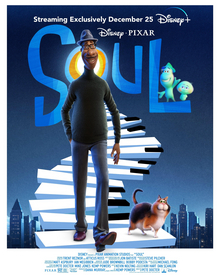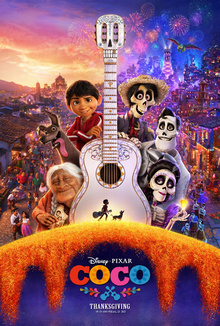(RNS) — This week, I was reminded of how the richness of Mormon theology can bubble up in unexpected places — in this case, the new Pixar movie “Soul.”
Tagline: Hollywood creations like “Soul,” “Coco” and the television show “The Good Place” are reminders that core Mormon ideas are alive in the popular imagination about the afterlife — and the “before life.”
I don’t want to give away “Soul”’s plot here since it’s so new. (Warning: I’m not as worried about spoilers for the other movies and television shows discussed here, which have all been out for more than a year. If you don’t want to know how “The Good Place” ends, stop reading immediately and go watch the show!)
Let me just say that “Soul” has a full-blown narrative about the premortal path of human beings. The “pre-existence” as conceived in Soul is not identical to what Latter-day Saints believe — there’s no war in heaven, and most fundamentally, no creator God. But it’s close in other details, like the idea that disembodied intelligences have core aspects of their eventual human personality and life spark already attached.
And most crucially, it’s rooted in the same core belief: that everyone who is walking on this earth does so because he or she made an active choice to come here.
The movie proves that in the negative: In “Soul,” there is a character who has bucked the tide of eternal progress for thousands of years, choosing to remain a disembodied spirit forever rather than move on with the expected plan of popping down to earth to gain a body. It’s only when “22” (gender is explicitly not fixed in the Pixar version of premortality, but the character’s vocalization as a white female has proved controversial) has an unplanned taste of human experience that she/it starts to understand that remaining stuck in the safe premortal world is more a curse than a blessing.
Mormons are not the only ones who have dreamed about “life before life” — Terryl Givens has a whole book that traces how these ideas of a premortal existence appeared in Western philosophy through history, even though they became heterodox in mainstream creedal Christianity. But the notion is fundamentally important in Latter-day Saint belief, and in some aspects of popular culture.
It’s not the only part of Mormonism’s theology of the human soul that has made it to the big or small screen in recent years. Another visible exponent is “The Good Place,” which I’ve written about before.
The good place, as Chidi eventually discovers, isn’t really a place at all; it’s a state of having enough time with the people you love. That will sound reassuringly familiar to Latter-day Saints. What’s more, it’s about eternal progress. One of the joys of the series is watching the main characters change and grow, deepening their relationships with one another and learning how to overcome the selfishness and insecurities that hurt them, and those who loved them, in life.
In the final season (spoiler alert), we see Mormon ideas of heaven triumph over traditional religious ideas. When the characters finally reach the Good Place, they find that this purported paradise is its own kind of hell. It’s damnation by sameness, where the “reward” of a life well lived is an endless vacation that’s free of responsibility and change. Heaven is, unexpectedly, a meaningless stretch of nihilism from which the damned and the saved are the very same people. And they cannot wait to escape.
Eleanor, Chidi, and the other main characters wrap up the final season by making over this traditional heaven as a more Mormon one, one that gives residents purpose and choices and human connection.
Human connection is the theme of another Pixar movie I love that evokes Mormon ideas of the afterlife: “Coco,” which explores the idea of eternal families. The film suggests that what we do on earth for our family members who have already died can be salvific —t hat the bond between us doesn’t end just because they’ve passed on to the other side. In “Coco,” the veil between those realms is thin on one night a year — November 1, or All Souls Day, when Mexican families have a celebration and a meal at the graves of their loved ones. It’s incumbent on the young main character to learn the history of his family so all of its members, living and dead, can be united for this occasion.
I am not saying that the filmmakers and writers who created these stories were influenced by LDS ideas or even exposed to them. I am saying that many of those ideas are universally appealing at a deep level, tapping into truths about life, death and love.
Our premortal and postmortal experiences, like our mortal ones, are about forging human connections, making choices, and fulfilling our purpose.
Related columns on Mormonism and popular culture:
6 reasons Mormons should check out ‘The Good Place’
Frozen in time: Mormons in the 24th century, as seen in ‘The Expanse’








